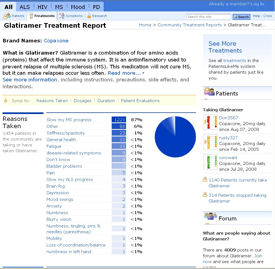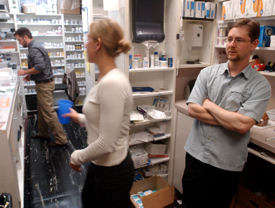Patients band together to research conditions, themselves
The next wave of online patient web sites allow patients to compare treatments and results, pulling together data that looks and acts like a research study despite its source.
Patients have long been using the Web as a medical reference tool, and increasingly, have turned to social networking sites where they can swap stories and advice about a common illness. The next wave of online, patient-centered health sites may well look something like PatientsLikeMe, which allows patients to share their experiences, learn about innovative treatments, and compare their treatments and symptoms to hundreds—or thousands—of other patients using real-world data.

Since its start in 2006, PatientsLikeMe has attracted more than 16,000 patient and 250 physician members who are registered under specific disease “communities,” including amyotrophic lateral sclerosis (ALS), multiple sclerosis and HIV/AIDS. Using data supplied by members, the site churns out an impressive display of bar and line graphs and other charts that are repeatedly updated to show the patient's experience over time. Members' profiles include such information as diagnosis date, first symptoms, family history, details of treatment regimens, severity and duration of symptoms, and primary and secondary outcome scores, all of which is fed into a larger disease-specific database.
The result is a compelling tool for patients with life-threatening diseases, but some physicians worry that patients will be misled. While visually impressive and easy to read, the site's statistics on symptoms and medications suggest “an accuracy and quality that may not be inherent in the source of the data,” wrote Paul Bleicher, MD, PhD, in the April 1, 2008 issue of Applied Clinical Trials. “If an influential member or two from the community start on a new medication and report a particular adverse effect, the occurrence of that adverse effect may be magnified within the community,” noted Dr. Bleicher, founder and chairman of Phase Forward, a clinical trials data collection and management company.
Such concerns may be legitimate, but “It's a reality we're going to have to adjust to, that patients are taking a more proactive approach to the management of their medical problems,” said William Hersh, FACP, chair of the department of medical informatics and clinical epidemiology at Oregon Health & Science University. “A lot of doctors are concerned about the patient who comes in with views inconsistent with the known science of health, but we need to work with those patients to add medical objectivity.”
Patients drive research
PatientsLikeMe was started by brothers Ben and Jamie Heywood and Jeff Cole, all Massachusetts Instutute of Technology-educated engineers. The idea came to the Heywoods while caring for their brother, Stephen, who was diagnosed with ALS in 1998 and who died just before the site launched. The first focus was on ALS, but the site now embraces other conditions. Its latest community, for people with mood disorders, is attracting more than 500 new members a month.
“We have a real-world database of patients, where everyone can learn from the collective knowledge of every other patient,” said Ben Heywood. “It shows what's happening in the real world, so patients can learn what are the most effective treatments other patients are using. “In essence, this is a real-world outcomes study.”
PatientsLikeMe allows members to search for information a number of ways, including by diagnosis, symptoms and treatment, and users can flip back and forth between data and patient stories. A member reading another patient's profile or comments can check for specifics on the patient's case, and since data is charted over time, it's possible to see, for instance, whether a given drug appears to help.

A recent trial started with PatientsLikeMe's ALS members illustrates both the potentially considerable benefits and the risks of the site's patient-driven approach. After discussing on the site's blog a paper published in the National Academy of Sciences that raised questions about the effectiveness of lithium in ALS, Jamie Heywood announced that PatientsLikeMe would run “the first real-time, real-world, open and non-blinded, patient-driven trial” where patients taking lithium prescribed by their physicians report changes as their treatment progresses. So far, 286 patients are enrolled.
For patients, the trial offers a much more immediate way of assessing the effectiveness and side effects of a widely used drug, but (as the Web site acknowledges), the placebo effect and patient bias could impact the quality of the data. In addition, noted Dr. Bleicher in Applied Clinical Trials, “The bias from openly available data is enormous, and the potential for incorrectly concluding that a possibly ineffective and toxic drug is effective is very high.”
Other concerns about the site include the influence of pharmaceutical companies and patient privacy. PatientsLikeMe does plan to make money by selling some of the data it collects to pharmaceutical, medical devices and health insurance companies and has already partnered with Novartis Pharmaceuticals for clinical trial recruitment, Ben Heywood said.
The company promises that any patient information sold for commercial or research purposes will be anonymous, however, though the site may eventually offer members an “opt-in” option that could allow companies to directly communicate with them, Mr. Heywood said.
Is it networking or research?
Mr. Heywood noted that the assessment tools the site uses to quantify patients' function, disease progression and symptoms are similar to those used by physicians and researchers. And, as demonstrated with the ALS lithium trial, real-time data has the potential to spot what is or isn't working before a clinical trial can provide definitive results, he said.
“I think in the long-term that we're going to be able to answer some very significant questions,” Mr. Heywood said. He stressed, however, that members are encouraged to always keep their doctors in the loop and to print out a “Doctor Visit Sheet” with their latest information to take to appointments.
But for doctors schooled in evidence-based medicine, the thought that treatment answers can emerge from patients swapping information doesn't sit quite right.
“Patients need to know that the information they're getting online is valid, based on the evidence shown in various studies,” said Neil J. Farber, FACP, clinical medical director for the Internal Medicine Group La Jolla at University of California San Diego and a member of the ACP's Ethics, Professionalism and Human Rights Committee. “Anyone who has a serious illness is very vulnerable.”
Rajnish Mago, MD, a psychiatrist at Thomas Jefferson University in Philadelphia, said he had mixed feelings when he registered as a physician in the mood disorders community at PatientsLikeMe.
“Right up front you should understand that this is a social networking Web site,” said Dr. Mago, who heads Jefferson's mood disorders program. “That is its main value, rather than as a source of authoritative health education. Its purpose is not to discuss what Harvard medical school has to say, or what scientists or physicians who are experts have to say.”
Web sites like this can be valuable sources of support and helpful tips from other patients. However, he cautioned that the information presented comes from patients who do not necessarily represent the experiences of all patients. For starters, the patients are self-selecting (people who are motivated to join an online community) and human nature is such that people are more likely to take the time to share bad information, such as unwelcome side effects, than benefits of treatment, he said.
“Patients may get misinformation,” Dr. Mago said. “In a discussion about withdrawal symptoms (from Effexor) patients were giving each other advice, some of which wasn't entirely correct.” He posted a suggestion and a reference to a paper he thought the members would find useful.
“If I advise my patients to explore this Web site,” said Dr. Mago, “I will make sure I discuss with the patients what they are reading on it.”



